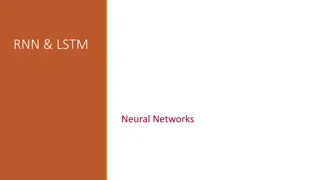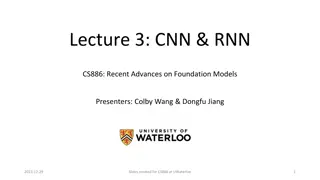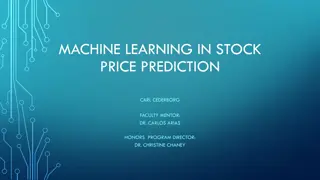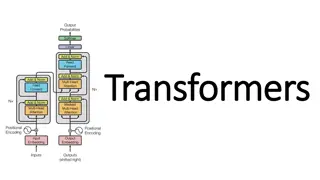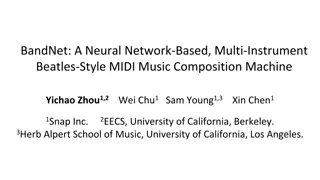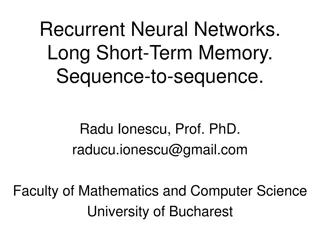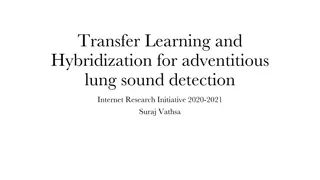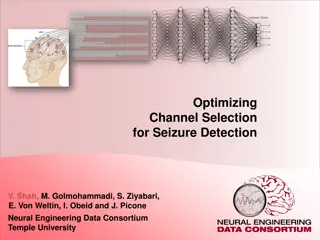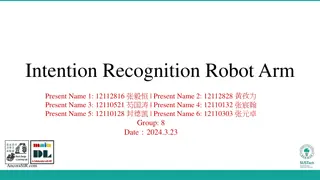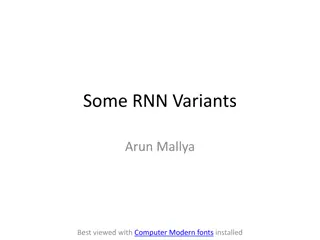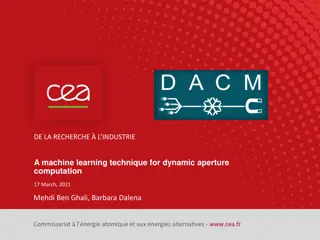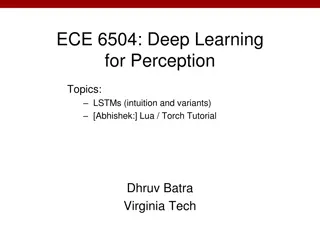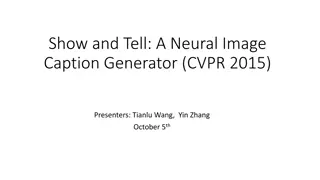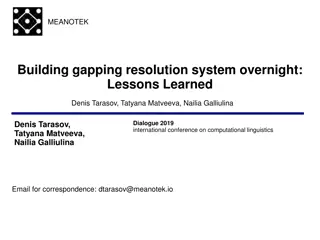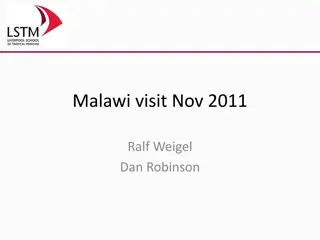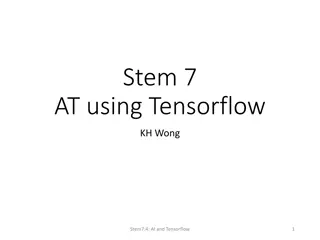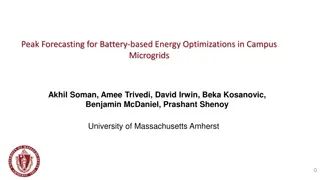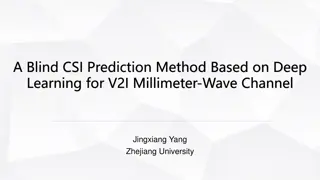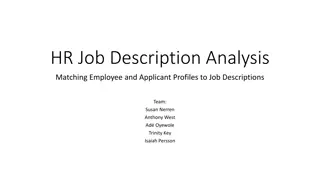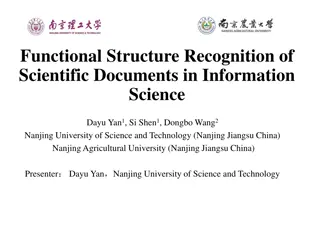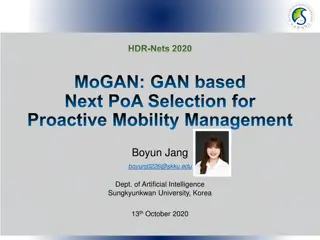Recurrent Neural Networks (RNN) and Long Short-Term Memory (LSTM)
Recurrent Neural Networks (RNNs) and Long Short-Term Memory (LSTM) are powerful tools for sequential data learning, mimicking the persistent nature of human thoughts. These neural networks can be applied to various real-life applications such as time-series data prediction, text sequence processing,
18 views • 34 slides
Recent Advances in RNN and CNN Models: CS886 Lecture Highlights
Explore the fundamentals of recurrent neural networks (RNNs) and convolutional neural networks (CNNs) in the context of downstream applications. Delve into LSTM, GRU, and RNN variants, alongside CNN architectures like ConvNext, ResNet, and more. Understand the mathematical formulations of RNNs and c
6 views • 76 slides
Machine Learning for Stock Price Prediction
Explore the world of machine learning in stock price prediction, covering algorithms, neural networks, LSTM techniques, decision trees, ensemble learning, gradient boosting, and insightful results. Discover how machine learning minimizes cost functions and supports various learning paradigms for cla
6 views • 8 slides
Evolution of Neural Models: From RNN/LSTM to Transformers
Neural models have evolved from RNN/LSTM, designed for language processing tasks, to Transformers with enhanced context modeling. Transformers introduce features like attention, encoder-decoder architecture (e.g., BERT/GPT), and fine-tuning techniques for training. Pretrained models like BERT and GP
15 views • 11 slides
BandNet: Neural Network-Based Multi-Instrument Music Composition
This research project introduces BandNet, a neural network-based system for multi-instrument Beatles-style MIDI music composition. By encoding musical scores using LSTM-RNN, the system addresses limitations of existing works and supports generating music scores for various purposes. Users can engage
2 views • 8 slides
Real-Time Network Traffic Prediction Using LSTM Neural Network
Explore Long Short-Term Memory (LSTM) models for real-time network traffic flow prediction. Learn about LSTM architecture, many-to-one vs. many-to-many models, and practical applications with market data. Gain insights into the unique formulation of LSTM networks for effective training and generaliz
0 views • 13 slides
Recurrent Neural Networks: Fundamentals and Applications
Explore the realm of Recurrent Neural Networks (RNNs), including Long Short-Term Memory (LSTM) models and sequence-to-sequence architectures. Delve into backpropagation through time, vanishing/exploding gradients, and the importance of modeling sequences for various applications. Discover why RNNs o
5 views • 102 slides
Advanced Artificial Intelligence for Adventitious Lung Sound Detection
This research initiative by Suraj Vathsa focuses on using transfer learning and hybridization techniques to detect adventitious lung sounds such as wheezes and crackles from patient lung sound recordings. By developing an AI system that combines deep learning models and generative modeling for data
2 views • 6 slides
Optimizing Channel Selection for Seizure Detection with Deep Learning Algorithm
Investigating the impact of different channel configurations in detecting artifacts in scalp EEG records for seizure detection. A deep learning algorithm, CNN/LSTM, was employed on various channel setups to minimize loss of spatial information. Results show sensitivities between 33%-37% with false a
6 views • 12 slides
Assistive System Design for Disabilities with Multi-Recognition Integration
Our project aims to create an assistive system for individuals with disabilities by combining IMU action recognition, speech recognition, and image recognition to understand intentions and perform corresponding actions. We use deep learning for intent recognition, gesture identification, and object
4 views • 14 slides
Recurrent Neural Networks (RNNs) and LSTM Variants
Explore the basics of Recurrent Neural Networks (RNNs) including the Vanilla RNN unit, LSTM unit, forward and backward passes, LSTM variants like Peephole LSTM and GRU. Dive into detailed illustrations and considerations for tasks like translation from English to French. Discover the inner workings
5 views • 36 slides
Machine Learning Technique for Dynamic Aperture Computation in Circular Accelerators
This research presents a machine learning approach for computing the dynamic aperture of circular accelerators, crucial for ensuring stable particle motion. The study explores the use of Echo-state Networks, specifically Linear Readout and LSTM variations, to predict particle behavior in accelerator
4 views • 17 slides
LSTMs for Deep Learning: A Visual Overview
Delve into the intricate workings of Long Short-Term Memory (LSTM) networks with a series of visual aids and explanations by Dhruv Batra. Explore the intuition behind LSTMs, including memory cells, forget gates, input gates, memory updates, and output gates, shedding light on how these mechanisms en
5 views • 17 slides
Neural Image Caption Generation: Show and Tell with NIC Model Architecture
This presentation delves into the intricacies of Neural Image Captioning, focusing on a model known as Neural Image Caption (NIC). The NIC's primary goal is to automatically generate descriptive English sentences for images. Leveraging the Encoder-Decoder structure, the NIC uses a deep CNN as the en
0 views • 13 slides
MEANOTEK Building Gapping Resolution System Overnight
Explore the journey of Denis Tarasov, Tatyana Matveeva, and Nailia Galliulina in developing a system for gapping resolution in computational linguistics. The goal is to test a rapid NLP model prototyping system for a novel task, driven by the motivation to efficiently build NLP models for various pr
2 views • 16 slides
Educational Exploration Trip to Malawi: Nov 2011 Report
The trip to Malawi in November 2011 aimed to establish educational links with institutions like the LightHouse trust, identify training needs, explore e-learning opportunities, and discuss collaboration possibilities. The project team, including members from LightHouse and LSTM, presented to key par
3 views • 11 slides
Tensorflow Installation and Applications
This content covers the installation process of TensorFlow along with tutorials, usage of Jupyter notebook, and various tests like music genre classification using CNN, Optical Character Recognition with Tesseract, and object recognition with Yolo. It also provides insights into using LSTM for music
3 views • 11 slides
Efficient and Effective Sparse LSTM on FPGA with Bank-Balanced Sparsity
Utilizing Bank-Balanced Sparsity, this work presents an efficient Sparse LSTM implementation on FPGA for real-time inference in various applications like machine translation, speech recognition, and synthesis. Through innovative design and evaluation, the model achieves high accuracy while maintaini
0 views • 52 slides
Peak Forecasting for Battery Optimization in Campus Microgrids
Smart microgrids with energy optimizations such as peak shaving and load flattening are becoming essential for efficient energy management. This study presents a machine learning-based approach, specifically LSTM models, for peak load forecasting in campus microgrids. The implementation includes a c
4 views • 10 slides
Using Sentence-Level LSTM Language Models for Script Inference
Event Inference Motivation: Building a Question Answering system requires the inference of probable implicit events. Explore how sentence-level LSTM language models can aid in script inference for improved understanding and context analysis. Delve into the methods, experiments, and conclusions drawn
1 views • 47 slides
Long Short-Term Memory Networks (LSTM)
Long Short-Term Memory Networks (LSTM) address the vanishing/exploding gradient problem in deep neural networks by utilizing memory cells and gating mechanisms. By controlling the flow of information, LSTMs can capture long-term dependencies, making them effective for sequential data tasks. The tran
0 views • 21 slides
Transformers: Neural Models for Language Processing and Tasks
Explore the evolution of neural models like RNN, LSTM, and Transformers for processing language and performing tasks such as classification, summarization, and sentiment detection. Learn how Transformers with features like attention have revolutionized context modeling, and how models like BERT and
3 views • 11 slides
Recurrent Neural Network with Sequential Weight Sharing
Explore how a recurrent neural network utilizes sequential weight sharing to process foveated input images, select actions, and achieve better generalization. The network aims to reduce parameters, input space, and computational resources while maintaining biological compatibility. Various methods,
3 views • 13 slides
GRU in Neural Networks
Explore the Gated Recurrent Unit (GRU) as a simpler variation of the LSTM model in neural networks. Learn about its advantages, properties compared to traditional LSTM, and how it mimics brain processes.
3 views • 38 slides
Blind CSI Prediction Method Based on Deep Learning for V2I Millimeter-Wave Channel
Explore a blind CSI prediction method utilizing deep learning for V2I millimeter-wave channels. The research delves into the application of 5G in vehicular communication scenarios, the sensitivity of mm-wave wireless systems, MEC and ACM technology, channel estimation techniques, and future CSI pred
3 views • 22 slides
Analyzing HR Job Description Matchings with Machine Learning Models
Explore how machine learning models like Naïve Bayes, K-Nearest Neighbors, and LSTM are utilized to match employee and applicant profiles with job descriptions at the City of Tulsa. Compare classification accuracies based on different attributes like department, group, and series. Gain insights int
4 views • 16 slides
Functional Structure Recognition Methods in Scientific Document Analysis
Explore the use of machine learning and deep learning techniques for recognizing the structural and functional aspects of academic texts, focusing on the application of models like BERT, LSTM, and TextCNN. The research involves data sourcing, annotation, and processing to enhance the understanding o
2 views • 10 slides
FlashP: Analytical Pipeline for Real-time Series Relational Data Forecasting
Explore FlashP, an analytical pipeline for real-time forecasting of time-series relational data. Learn about tasks like decision-making on online advertising platforms, bottleneck speedup via sampling, and the use of generalized weighted samplers for accurate estimation. Dive into forecasting with n
3 views • 14 slides
Proactive Mobility Management with GAN-based Prediction
Explore how GAN-based Next Point of Attachment (PoA) prediction enhances proactive mobility management for 5G, overcoming challenges of dense cell deployment. Delve into deep learning approaches like LSTM, GRU, and GAN for accurate predictions and optimal handover decisions in real-time scenarios.
3 views • 22 slides
Recurrent Encoder-Decoder Networks in Time-Varying Predictions
Explore the power of Recurrent Encoder-Decoder Networks for time-varying dense predictions, challenges with traditional RNNs, modifications like GRU and LSTM, bidirectional RNNs, and the fusion of CNN and RNN in CRNN for spatial-temporal data processing.
0 views • 10 slides
RNNs, LSTMs, and Gradient Issues in Deep Learning
Dive into the world of Recurrent Neural Networks (RNNs) and Long Short-Term Memory (LSTM) networks, exploring concepts such as exploding and vanishing gradients. Discover how LSTM solves the vanishing gradient problem and learn about gradient clipping. Explore various implementations and references
4 views • 13 slides
BERT and Deep Learning for Persian Text Sentiment Analysis
Explore how BERT and Deep Learning techniques are leveraged for sentiment analysis on Persian texts. The project discusses problem statements, input and output samples, challenges like Named Entity Recognition, and past solutions such as Skip-gram models and LSTM. The solution proposed involves Bidi
2 views • 25 slides
LSTM Core Concepts
The long short-term memory (LSTM) model is a crucial component in understanding recurrent neural networks. It comprises key ideas such as backbone state carrying and gradient modulation through gating mechanisms. The core concepts involve forget gates, input gates, updates to the internal state, and
1 views • 8 slides
Decoding LSTM: Core Ideas and Gating Mechanisms
Delve into the intricate workings of Long Short-Term Memory (LSTM) networks, understanding the core concepts such as backbone state propagation, gradient modulation through gating mechanisms, and the crucial functions of forget and input gates. Explore how LSTM transforms information flow and enhanc
2 views • 17 slides
RNN and LSTM in Neural Networks
Explore the concepts of Recurrent Neural Networks (RNN) and Long Short-Term Memory (LSTM) networks, including how LSTM addresses the vanishing gradient problem. Learn how these models are used in applications like machine translation and the different types of RNN processing modes. Discover the loop
0 views • 34 slides
Innovative Health Sector Capacity Building Program in Malawi
Explore the partnership debriefing between Lighthouse, LSTM, and health and education stakeholders, focusing on enhancing CPD initiatives in Malawi. Objectives include building capacity, incorporating technology, developing marketing plans, and establishing national and international partnerships.
2 views • 8 slides
Acoustic Scene Classification with Deep Learning
Explore acoustic scene classification using deep learning techniques to identify the environment of audio clips, with applications in surveillance, aiding disabled individuals, and context-aware computing. Discover related works in CNN and LSTM combinations for audio classification, addressing the g
1 views • 6 slides
Proactive Caching with Bidirectional Neural Networks
Enhance mobile edge computing efficiency with an online proactive caching scheme utilizing bidirectional deep neural networks. Learn how machine learning methods optimize content popularity predictions to reduce latency and backhaul traffic. Explore the system model and the use of CNN, BRNN, RNN, an
1 views • 12 slides
Understanding LSTM and GRU Architectures
Explore the structures of LSTM and GRU neural networks, with insights on LSTM core ideas, gating mechanisms, and the role of RNN dropout for regularization. Learn about state maintenance, information flow modulation, and output gate modulation in LSTM, as well as the combination of forget and input
1 views • 8 slides
